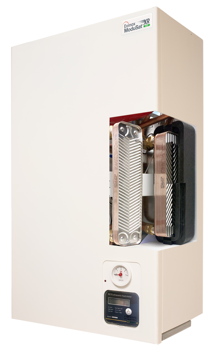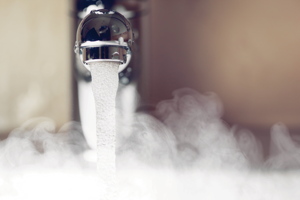Efficiency in mind

Communal heating systems and district heat networks are considered by the UK Government as one of the most cost-effective ways of reducing carbon emissions from heating, especially as their efficiency and carbon-saving potential increases as they grow and connect to each other. They also provide a unique opportunity to exploit larger-scale, and often lower-cost, renewable and recovered heat sources that otherwise cannot be used.
But are heat networks delivering the savings that policy presumes? Are these systems being designed with efficiency in mind? And what considerations should specifiers be taking into account when selecting equipment, particularly heat interface units (HIU’s)?
By far the most popular HIU type for residential district and communal heating systems is the installation of “instantaneous” or “twin plate” units. These provide separate hydraulic interfaces between the “primary” heat network and the “secondary” heating and hot water systems for each flat or dwelling. These units provide instantaneous domestic hot water by raising the temperature of incoming mains cold water supply on demand, to provide water at a comfortable (and safe) temperature for bathing or sanitary purposes.
System design
This is one of the key opportunities for system designers and specifiers to affect the efficiency of the heat network. It is important to ensure that the HIU’s selected are able to deliver a wide delta T (temperature differential) between the primary flow and return and that they provide low return temperatures back to the network.
All too often, systems are designed primarily to ensure delivery of hot water abundance at the expense of system efficiency and the very carbon savings heat networks are intended to deliver.
HIU’s need to be selected to deliver the required hot water kW demand, at the design flow temperature (usually 55°C), based on the required flow rate and the energy the hot water plates can deliver at the network primary temperature (for example 70°C).
 |
|
A smart heat interface unit |
Frequently however, we see systems that are designed for unrealistically high peak domestic hot water capacities. Fundamentally designers simply size the required HIU hot water capacity to ensure that even in the most extreme of unlikely circumstances, home occupiers will never have cause to complain about the systems capability to deliver plentiful hot water. By this I mean the ability of the HIU to deliver hot water at full design flow rate and temperature – across every conceivable combination of hot water outlet being open simultaneously - kitchen sink, bathroom basin, shower, bath, en suite, etc.
Oversizing issues
The result is the installation of HIU’s with oversized domestic hot water plates, which in turn requires a supporting heat network that is oversized to support these theoretically high demands. In turn, we see oversized system pipework, resulting in higher heat losses; oversized pumping requirements resulting in unnecessary additional energy consumption; and oversized and inefficient heat generation plant.
Unnecessary oversizing of the HIU plate heat exchangers can also lead to low velocity and therefore a less turbulent, even laminar, flow. This reduces the “self-cleaning” effect of the plate heat exchangers, increasing the likelihood of dirt settling and limescale build-up inside the heat exchangers which will lead to reduced heat transfer and a higher return temperature.
Adopting a more pragmatic approach to HIU sizing – based on typical, rather than “peak” DHW demand, eliminates these issues, as well as helps to reduce overall capital cost and help drive up network efficiency. Designing for nominal rather than peak flow rates, means smaller bore pipework can be used.
Keep Warm
The other key area that designers focus on is hot water speed of response. The ability of an HIU to deliver hot water to the tap quickly is most commonly a function of a feature known as the ‘Keep Warm Facility’ (also known as ‘stand by’).
Simply put, this function allows warm water from the primary to bypass the hot water plate, keeping the plate warm and “ready for action” as soon as there is a demand for hot water in the dwelling.
Keep Warm requires the use of energy, to keep both the HIU hot water plate – and the accompanying lateral pipework – at or near the target hot water temperature. The closer to the target temperature the Keep Warm is set, the faster the HIU will deliver hot water to the tap.
Independent test results published as part of the BESA UK Standard for HIUs can be used to help illustrate this point very well. The key metric from the test standard is the HIU’s VWART (Volume Weighted Average Return Temperature). This is an indication of an HIU’s ability to achieve a wide temperature differential (delta T) – and therefore low return temperatures – in a series of standardised operating conditions.
The VWART figure clearly reflects the efficiency of the plate heat exchangers and valves used in the HIU, and it also shows that improvements can be made by adjusting the keep warm strategy and allowing the DHW response time to increase. It may take slightly longer to achieve warm water delivery to occupants, but energy savings are significant.
With the new generation of electronically controlled ‘smart HIUs’ on the market, the ability to provide both time and temperature control over the keep warm function is going to have an impact on reducing network energy consumption. The ability to configure and adjust both the timings and the keep-warm temperature set points remotely after commissioning also gives network operators the opportunity to decide the best solution for their specific heat network and to make system efficiency improvements over time.
 |
|
Delivery of hot water should not be at the expense of efficiency Credit: Shutterstock:nikkytok |
Find your strategy
For example, is DHW response time for the residents the most important consideration? Or the overall efficiency of the heat network? Operators can gradually reduce the keep warm set points across the network and monitor customer feedback, in order to arrive at an optimal balance between network efficiency and customer satisfaction.
These advanced features are only possible with the latest generation of remotely connected HIU’s which provide the ability for these settings to easily adjusted through internet connectivity.
Giving the operator of the heat network the flexibility to continually improve the network performance is crucial. After all, they will know their system and residents better than any of us.
As long as we give the operator the information and benefits of different options, why not let them decide? With the new generation of smart HIUs, they have the flexibility to find the strategy for their building.
Helen Gibbons is technical and design manager, Evinox Energy







